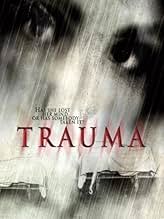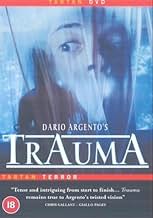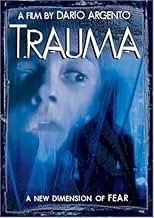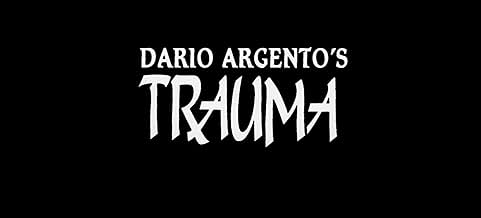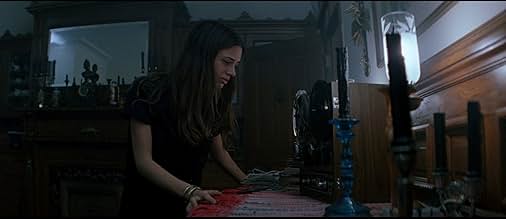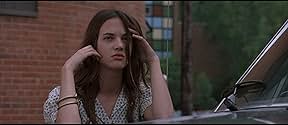IMDb-BEWERTUNG
5,8/10
8582
IHRE BEWERTUNG
Füge eine Handlung in deiner Sprache hinzuA young man tries to help a teenage girl find the serial killer who murdered her parents before the killer comes after them.A young man tries to help a teenage girl find the serial killer who murdered her parents before the killer comes after them.A young man tries to help a teenage girl find the serial killer who murdered her parents before the killer comes after them.
- Auszeichnungen
- 2 Nominierungen insgesamt
Isabell O'Connor
- Georgia Jackson
- (as Isabell Monk)
Empfohlene Bewertungen
Argento's American filmed giallo movie in which an unknown killer decapitates victims using a small mechanical device during rain storms. One kill is achieved by first activating a motel room fire extinguisher before execution. I liked this aspect of the movie. I noticed a few nods to Hitchcock too, some music and a shower scene. Dario's daughter Asia, 18 at the time, stars. A very attractive young woman and I am no prude but I felt her brief topless scene was not really necessary,
One of the things that spoilt Trauma was for me what I can only describe as silliness, one decapitated head manages to utter a name, another yells out loud as it falls down a lift shaft. Some of the musical score would not be out of place in a comedy, so different from the Goblin soundtracks from Argento's classics. Trauma looked like nothing more than a straight to video movie, the production values were no better than a half decent TV film. When the end credit roll we suddenly get a random reggae band playing at some house. Strange.
As a crime thriller/horror film Trauma is reasonable but as an Argento movie it is disappointing. Not his worst film but very poor compared to the likes of Deep Red and Suspiria.
When I picked up TRAUMA at the vid-store, I wasn't really expecting much from it. I'm not a big Argento fan, but I do enjoy Italian horror/cult films. I have to say, I was totally impressed by it! It was a surprisingly great horror-suspense film with great camera work & gore as well. A lot of familiar faces in this film including James Russo, Cristopher Rydell, and Piper Laurie who you might remember from THE FACULTY. Also the lovely Asia Argento who commands the movie like she did in Michele Soavi's THE CHURCH.
Before URBAN LEGEND, I KNOW WHAT YOU DID LAST SUMMER 16, & SCREAM 3000 there was Dario Argento's TRAUMA. And if you enjoyed any of those similar movies you should love this one as well. Except this one is ten times more scarier and realistic with tons of unexpected plot twists that would put all those movies to shame. Its just too bad Argento doesn't make any more horror movies 'round these parts.
Before URBAN LEGEND, I KNOW WHAT YOU DID LAST SUMMER 16, & SCREAM 3000 there was Dario Argento's TRAUMA. And if you enjoyed any of those similar movies you should love this one as well. Except this one is ten times more scarier and realistic with tons of unexpected plot twists that would put all those movies to shame. Its just too bad Argento doesn't make any more horror movies 'round these parts.
A young man (Christopher Rydell) finds an bulimic girl (Asia Argento) who has escaped her parents. When returned to them, a killer with a unique mechanical decapitation device strikes. Soon, the two must find out who the killer is, and what they want.
Released in 1993, "Trauma" has received some flak from Dario Argento fans, who consider it one of his weaker efforts. In a way, I can agree-the movie has several plot holes, the acting is largely hit and miss (Asia is pretty inexperienced here), and it's not as gory and stylish as his other films.
Yet, there's still plenty to recommend in this movie. The movie is Argento's more character and plot oriented films, and it's surprisingly easy to follow. There's also still plenty of Argento's wonderful stylish touches, and while not as gory as his previous movies, there's still some great kills (including a great bit involving an elevator). The score by Pino Donnaggio, while not as good as Argento's past musicians, is still up to task. Finally, the presence of several acting vets (including James Russo, Brad Dourif, Frederic Forrest, and an excellent Piper Laurie) don't hurt at all.
"Trauma" is not Argento's best movie, and certainly pales in comparison to movies like "Deep Red", "Suspiria", and "Inferno." As it stands though, it's an underrated movie, and worth a look, especially if you are an Argento fan.
Released in 1993, "Trauma" has received some flak from Dario Argento fans, who consider it one of his weaker efforts. In a way, I can agree-the movie has several plot holes, the acting is largely hit and miss (Asia is pretty inexperienced here), and it's not as gory and stylish as his other films.
Yet, there's still plenty to recommend in this movie. The movie is Argento's more character and plot oriented films, and it's surprisingly easy to follow. There's also still plenty of Argento's wonderful stylish touches, and while not as gory as his previous movies, there's still some great kills (including a great bit involving an elevator). The score by Pino Donnaggio, while not as good as Argento's past musicians, is still up to task. Finally, the presence of several acting vets (including James Russo, Brad Dourif, Frederic Forrest, and an excellent Piper Laurie) don't hurt at all.
"Trauma" is not Argento's best movie, and certainly pales in comparison to movies like "Deep Red", "Suspiria", and "Inferno." As it stands though, it's an underrated movie, and worth a look, especially if you are an Argento fan.
An anorexic teenager sees her parents murdered and thinks the killer could be coming after her next, so it's up to a struggling addict to keep her safe.
Dario Argento's flair for over the top gory set pieces isn't as noticeable here and everything feels more calm and by the numbers, but every now and then, there's a shot or sequence that feels like old fashioned Argento and those moments are worth watching it for. It's also interesting to see a film of his that appears to use all live audio from the set and that takes place in America. It's jarring at first, but you get used to it.
Dario Argento's flair for over the top gory set pieces isn't as noticeable here and everything feels more calm and by the numbers, but every now and then, there's a shot or sequence that feels like old fashioned Argento and those moments are worth watching it for. It's also interesting to see a film of his that appears to use all live audio from the set and that takes place in America. It's jarring at first, but you get used to it.
There are some good stuff here to be sure. Argento-fans tend to rate this way down on the scale and criticize it for being to "americanized". I don't agree. Sure, there is a certain sense of "half-baked Argento" here and there, but I don't find that to be a minus point. If anything, being made in the states, it has more convincing performances and the production values can not be faulted. It's look may seem aneamic if viewed beside "Suspiria" or something more of Argento's more gaudy creations, but I think that this is intentional. Cinematography it absolutely top-notch, conveying a suitably spooky atmosphere to many scenes. The story is fairly straight-forward for an Argento movie, but not standard fare, and if this had been made by a newcomer it would have been hailed as very solid suspenser indeed. The plot twists and turns even if the outcome isn't too much of a surprise. However, one thing really bothers me about "Trauma". The sfx-work by Tom Savini is truly awful. Some scenes, like the one in the elevator-shaft, start creepy enough but are ruined by the effects overall cheesiness (the falling head is only laughable instead of frightening). Shame on you, Savini! Bring on Sergio Stivalletti! Another thing that's not very good is Pino Donaggios score, which he seems to have composed in his sleep. It's not bad, it's just that it seems so routine. Compared to "Deep red" and a few others, this is not Argento at his best. But even Argento at half-speed is better and more interesting than most directors produce within a lifetime.
Wusstest du schon
- WissenswertesThe character played by Asia Argento is inspired by her half-sister Anna (Nicolodi's daughter from a previous marriage) who actually suffered from anorexia. Anna died in a scooter accident in 1994 shortly after the film's release, but she is seen in the actual movie during the closing credits dancing in the balcony.
- PatzerThe newscaster says that Dr. Judd died on impact at the scene of the accident, but he actually delivers some last words before succumbing.
- Alternative VersionenA special uncut version reportedly available on video features 7 minutes of footage omitted from foreign prints including:
- a new introduction of the Aura and David characters: David (Chris Rydell) drives Grace (Laura Johnson) to the airport and sees Aura (Asia Argento) being beaten by a man whose plane ticket she tried to steal;
- a new scene features Grace visiting David at the TV station and asking him about Aura; David invites Grace to his house and then calls Aura at home to ask her if she needs any food; Aura lies to him and tells she's already eaten;
- Aura visits a market and is spotted by Dr. Jarvis (Frederic Forrest), who tries to catch her;
- After David and Aura escape from the Marigold, she tells him she's taken a little souvenir from Nurse Volkmann's purse; another new shot shows the Marigold's owner talking to the police;
- David checks into a hotel after following Linda Quirk's car and asks for a room overlooking the parking lot;
- David asks for information about Dr. Lloyd in a saloon;
- After David calls Grace and asks her for prescription forms, she meets and confronts him, trying to make him face the fact that he's become a junkie;
- The death scenes of Linda Quick and of the killer are more graphically explicit (the wire is seen cutting through Linda's neck).
- VerbindungenFeatured in Dario Argento: Mein Kino (1999)
- SoundtracksRuby Rain
Sung by Laura Evan
Lyrics by Paolo Steffan
Music by Pino Donaggio
Arranged and Performed by Paolo Steffan
Top-Auswahl
Melde dich zum Bewerten an und greife auf die Watchlist für personalisierte Empfehlungen zu.
Details
Box Office
- Budget
- 7.000.000 $ (geschätzt)
- Weltweiter Bruttoertrag
- 475 $
- Laufzeit
- 1 Std. 46 Min.(106 min)
- Farbe
- Sound-Mix
- Seitenverhältnis
- 2.35 : 1
Zu dieser Seite beitragen
Bearbeitung vorschlagen oder fehlenden Inhalt hinzufügen


